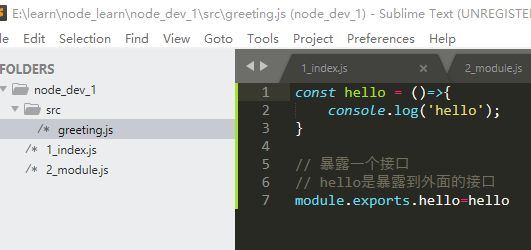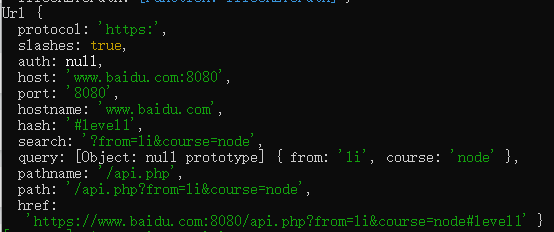1.Node.js模块
- 内置的Node.js模块
const os = require('os');
console.log(os.hostname());
2.第三方的Node.js模块
当需要安装第三方的包时,可以在如下网址进行查询。
https://www.npmjs.com/
npm为我们提供了包管理文件package.json,在项目目录中,首先使用npm init就会生成package.json。
npm init
npm install --save 包名(要用的包)
npm install --save-dev 包名(debug用的包)
安装的包会在项目目录/node_modules中
使用包时与第一步相同,node首先会在内部查找,没有的话就去node_modules里面查找。
3.自定义的Node.js模块
在外面使用此自定义模块
- 暴露多个内容:
const hello = ()=>{
console.log('hello');
}
let msg = '你好';
module.exports.hello = hello;
module.exports.msg = msg;
在require的时候,module.export的名字就是greeting,相当于增加了一个顶层变量,所有的函数变量都要从这个顶层变量走。
-
暴露一个类
- 使用
// 使用一个类
const People = require('./src/people.js');
let xiaoming = new People('小明', '12');
xiaoming.sayHello();
2.nodejs提供的核心内置模块讲解
node.js官方文档
http://nodejs.cn/api/
2.1 url模块
url模块主要用于解析url地址
const url = require('url');
console.log(url);
- url.parse(参数为url地址)
将url字符串解析为对象
// 第二个参数,ture表示query为对象形式
console.log(url.parse('https://www.baidu.com:8080/api.php?from=li&course=node#level1',true));
- url.format(参数为url对象)
将对象解析为字符串
const urlObject= {
protocol: 'https:',
slashes: true,
auth: null,
host: 'www.baidu.com:8080',
port: '8080',
hostname: 'www.baidu.com',
hash: '#level1',
search: '?from=li&course=node',
query: { from: 'li', course: 'node' },
pathname: '/api.php',
path: '/api.php?from=li&course=node',
href:
'https://www.baidu.com:8080/api.php?from=li&course=node#level1'
}
console.log(url.format(urlObject));
结果
- url.resolve(url1,url2)
将两段url解析成完整的url
console.log(url.resolve('https://www.baidu.com','/api/list.php'));
2.2 querystring模块
const querystring = require('querystring');
console.log(querystring);
- querystring.stringify(参数对象)
用于将对象转换成以&形式相连的参数字符串
console.log(querystring.stringify({name:'qian',course:['nodejs','vue.js'],from:''}));
结果:
name=qian&course=nodejs&course=vue.js&from=
也可以自定义分隔符
// 生成的字符串以,分隔
console.log(querystring.stringify({name:'qian',course:['nodejs','vue.js'],from:''},','));
name=qian,course=nodejs,course=vue.js,from=
键值对之间以:分割
// 键值之间以:分割
console.log(querystring.stringify({name:'qian',course:['nodejs','vue.js'],from:''},',',':'));
name:qian,course:nodejs,course:vue.js,from:
- query.parse(字符串)
将字符串转化成对象
console.log(querystring.parse('name=qian&course=nodejs&course=vue.js&from='));
console.log(querystring.parse('name=qian,course=nodejs,course=vue.js,from=',','));
console.log(querystring.parse('name:qian,course:nodejs,course:vue.js,from:',',',':'));
- querystring.escape(字符串)
将字符串进行编码
console.log(querystring.escape('北京'));
console.log(querystring.unescape('%E5%8C%97%E4%BA%AC'));
2.3 http模块
- 创建服务器
// http模块
// 引用http模块
const http = require("http");
// 创建一个服务器。回调函数表示接收到请求之后做的事情
let server = http.createServer(function(req, res) {
// req参数表示请求,res表示响应
console.log('服务器接收到了请求'+req.url);
//此方法向服务器发出信号,表明已发送所有响应头和主体,该服务器应该视为此消息已完成。 必须在每个响应上调用此 response.end() 方法。
res.end();
});
//监听端口
server.listen(3000,'127.0.0.1');
// 此方法用于设置响应头
res.writeHead(200, {
'Content-Type': 'text/plain;charset=UTF8',
});
- get请求
// https Get请求
const https = require('https');
let options = {
hostname : 'api.douban.com',
port : 443,
method : 'GET',
path : '/v2/movie/top250'
}
let request = https.request(options, (response)=>{
console.log(response);
})
request.on('error', (error)=>{
console.log(error);
})
request.end();
- post请求
在使用post请求时,将数据拆分成了众多的数据块chunk,通过特定事件,将这些小数据块有序的传递给回调函数。
const http = require ("http");
const querystring = require("querystring");
http.createServer(function(req,res) {
// 如果请求来源是/dopost ,并且请求方法时post
if(req.url == "/dopost" && req.method.toLowerCase() == "post"){
// 使用post请求时,将数据拆分成了众多的数据块chunk,通过特定事件,将这些小数据块有序的传递给回调函数。
let alldata = "";
req.addListener("data", function(chunk) {
alldata += chunk;
});
// 全部传输完毕
req.addListener("end", function() {
let dataString = alldata.toString();
// 将请求数据转换为对象类型,我们就可以直接使用
let dataObj = querystring.parse(dataString);
res.end();
});
}
}).listen(80, '127.0.0.1');








